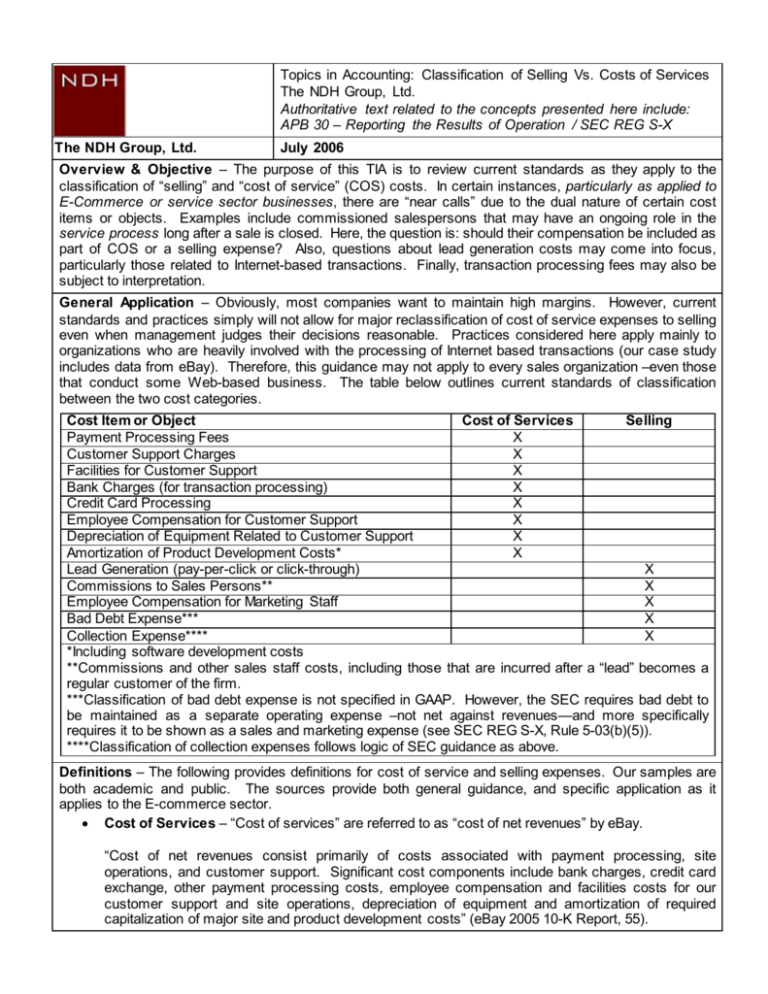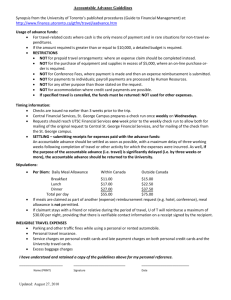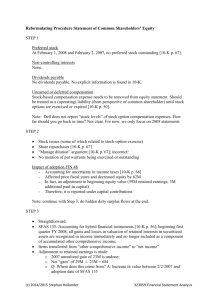Topics in Accounting: Classification of Selling Vs
advertisement

Topics in Accounting: Classification of Selling Vs. Costs of Services The NDH Group, Ltd. Authoritative text related to the concepts presented here include: APB 30 – Reporting the Results of Operation / SEC REG S-X The NDH Group, Ltd. July 2006 Overview & Objective – The purpose of this TIA is to review current standards as they apply to the classification of “selling” and “cost of service” (COS) costs. In certain instances, particularly as applied to E-Commerce or service sector businesses, there are “near calls” due to the dual nature of certain cost items or objects. Examples include commissioned salespersons that may have an ongoing role in the service process long after a sale is closed. Here, the question is: should their compensation be included as part of COS or a selling expense? Also, questions about lead generation costs may come into focus, particularly those related to Internet-based transactions. Finally, transaction processing fees may also be subject to interpretation. General Application – Obviously, most companies want to maintain high margins. However, current standards and practices simply will not allow for major reclassification of cost of service expenses to selling even when management judges their decisions reasonable. Practices considered here apply mainly to organizations who are heavily involved with the processing of Internet based transactions (our case study includes data from eBay). Therefore, this guidance may not apply to every sales organization –even those that conduct some Web-based business. The table below outlines current standards of classification between the two cost categories. Cost Item or Object Cost of Services Selling Payment Processing Fees X Customer Support Charges X Facilities for Customer Support X Bank Charges (for transaction processing) X Credit Card Processing X Employee Compensation for Customer Support X Depreciation of Equipment Related to Customer Support X Amortization of Product Development Costs* X Lead Generation (pay-per-click or click-through) X Commissions to Sales Persons** X Employee Compensation for Marketing Staff X Bad Debt Expense*** X Collection Expense**** X *Including software development costs **Commissions and other sales staff costs, including those that are incurred after a “lead” becomes a regular customer of the firm. ***Classification of bad debt expense is not specified in GAAP. However, the SEC requires bad debt to be maintained as a separate operating expense –not net against revenues—and more specifically requires it to be shown as a sales and marketing expense (see SEC REG S-X, Rule 5-03(b)(5)). ****Classification of collection expenses follows logic of SEC guidance as above. Definitions – The following provides definitions for cost of service and selling expenses. Our samples are both academic and public. The sources provide both general guidance, and specific application as it applies to the E-commerce sector. • Cost of Services – “Cost of services” are referred to as “cost of net revenues” by eBay. “Cost of net revenues consist primarily of costs associated with payment processing, site operations, and customer support. Significant cost components include bank charges, credit card exchange, other payment processing costs, employee compensation and facilities costs for our customer support and site operations, depreciation of equipment and amortization of required capitalization of major site and product development costs” (eBay 2005 10-K Report, 55). The NDH Group, Ltd., Page 2 • Topics in Accounting: Classification of Selling vs. Cost of Services Selling – “Selling” costs are referred to by eBay as “sales and marketing expenses,” and include advertising expenses, which are primarily “click-through” fees. “Sales and marketing expenses consist primarily of advertising, tradeshow, and other promotional costs, employee compensation for our category development and marketing staff and certain trust and safety programs” (eBay 2005 10-K Report, 56). “Internet advertising expenses are recognized based on the terms of the individual agreement [and include] pay-per-click…” (eBay 2005 10-K Report, 88) “Selling expenses include the costs of storing and preparing goods for sale; displaying, advertising, and otherwise promoting sales; making the sales; and delivering the goods to the buyer if the seller bears the cost of delivery” (Needles, 178). “Selling expenses are those expenses directly related to the company’s efforts to generate sales (e.g., sales salaries, commissions, advertising, delivery expenses, depreciation of store furniture and equipment, and store supplies)” (Epstein, 72). “Sales commissions are not included in the determination of inventory cost” (Nikolai, 7-4). Notes eBay 2005 10-K Report – See SEC 10K Report Year Ended 2005 (filed February, 24 2006) Epstein, Nach, Black, and Delaney “Wiley GAAP 2005” Needles, Anderson, and Caldwell “Principals of Financial Accounting” (Fifth Edition) Nikolai and Bazley “Intermediate Accounting” (Eighth Edition) Taub and Sondhi “Miller Revenue Recognition Guide, 2006” Further Instruction & Use – For further information regarding the Classification of Selling Vs. Costs of Services contact The NDH Group, Ltd. at 312.461.0876 | www.ndhcpa.com





